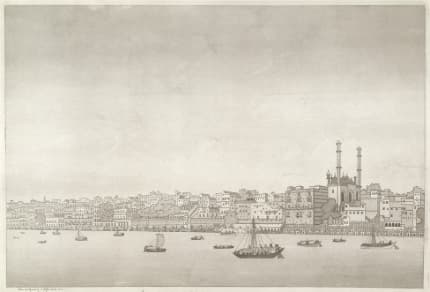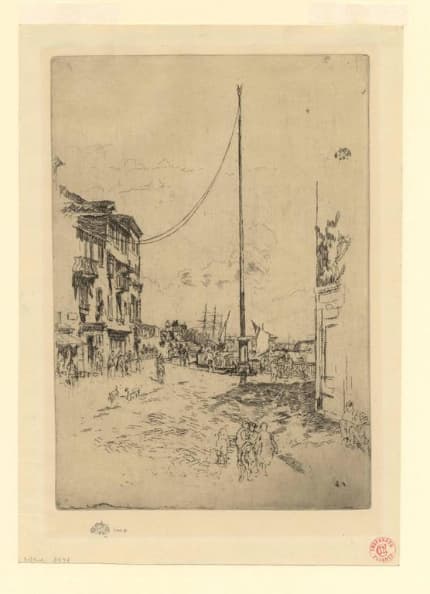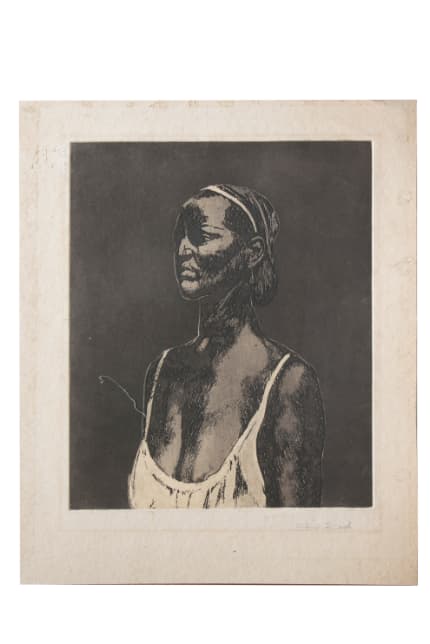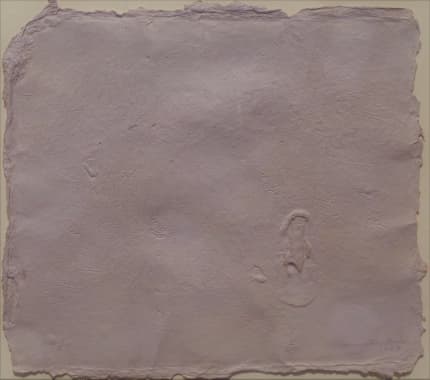In simple terms, a print is created where ink is transferred from a block or plate on to a paper. Depending on the technique used, there are different outcomes and as a result, they have been further divided into categories. Each printing technique has its own distinctive style depending on the tools and materials used.

James Moffat, 1st View of the City of Benaras, 1804, Aquatint Etching
Source: British Library Collection
Initially, early printmaking was made to make multiple copies of the same work because it was much faster than making each one by hand. It was only later that people realized that the drawing that went into print could be made to be art on its own. It did not have to be a supplement; it could be its own creation.
What is an original print?
An original print is when an artist decides to create a work specifically to be printed. For example, when we buy a poster of the Mona Lisa from the gift shop in the Louvre, we know that print of the poster was definitely not made for the buyer. Leonardo Da Vinci intended to make the Mona Lisa as an original painting, not an original print. Similarly, when an artist thinks of an idea or concept and sets out to make a print and does not choose any other medium - that is an original print! Sometimes, we see a painting and a print that looks exactly the same. However, if the print was made after the painting was made, it is not considered to be an original print.
Albrecht Dürer was the master of 16th-century prints. Today, he is still considered to be one of the best portrait engravers. Although he lived in Germany, he was one of the few people who traveled all the way to Italy for his art. His prints often had subject matter that was related to religion, history, mythology, and folklore. Dürer experimented with his engravings and woodcuts, etchings and drypoints. He often made prints of works that he already drew before. Dürer is well known for his monogram - AD; which was one of the first copyrights in art history.
His depiction of the Rhino is one of the most famous works of an animal.

Albrecht Dürer, Rhinoceros, 1515, Woodcut
Source: British Museum
James Whistler, the 19th century U. S. painter was one of the first few people who hand-signed his prints. Today, signing prints has become very common. The artist usually signs and numbers the print or labels it as an artist's proof.

James Whistler, The Little Mast, 1879, Drypoint Etching
Source: 1stDibs
The Japanese master of woodcut, Hokusai, was born near Edo (Tokyo) and started to make when he was 15 years old. The Great Wave off Kanagawa, Hokusai's most famous print, the first in the series 36 Views of Mount Fuji is his mount popular print. His works became so famous that he also made an impact in the European art world. Vincent Van Gogh was immensely inspired by his works and imitated his style of woodblock printing in his own art.

Katsushika Hokusai, The Breaking Wave off Kanagawa, from the series Thirty-six Views of Mount Fuji
woodblock colour print, 1829 – 1833
Source: Wikimedia
Intaglio Print
Intaglio prints use a method where an image is cut or incised onto a surface and the sunken area traps and hold the ink. Usually, copper or zinc plates are used as the surface, and incisions are made on it which is then coated with a paper. As the ink settles into the grooves and the surface is wiped clean of ink, the paper has a lot of pressure put on it so the ink can transfer completely. The image on the paper then has a 3D looking effect
Bikash Bhattacharjee, Untitled, Circa 1980s
Lithograph (Type of Intaglio print)
Lithographs
When a lithograph is made, the image is drawn with a litho crayon or greasy ink on the plate. It is then covered with a mixture of gum arabic and nitric acid. The main idea behind lithography is that water and oil do not mix. The positive image attracts the oily ink and the negative repels it. As a result, when the stone is dampened with a sponge and an ink saturated roller is passed over it, the ink is deposited on the greasy ink but not on the wet stone. The ink does not smear and there is no seepage. When the paper is put on the stone and it goes through the press, the image is transferred to the paper. 
Somnath Hore, Untitled, Lithograph, 1980
Relief Print
Relief printing is when a printing block has ink on its surface but not on any sunken areas. The plates are brought into contact with the paper and the sunken areas leave a black space on the papers. Usually, the paper is pressed by hand or with a roller. In relief processes, the negative, or non-printing part of the block or plate, is either cut or etched away. The print looks like it is a positive image and represents the printing surface.

Zarina Hashmi, Riders, 1968, Relief print from collaged wood on handmade paper
Woodcut
Woodcut is the earliest known relief-printing method. In this method, the design is first drawn and the surface of the wood is cut away around the design. For fine details and outlines, the knife is used; larger areas are removed with gouges.

Haren Das, Untitled, Woodcut, 1963
Viscosity Print
Viscosity print is a printing technique that incorporates elements from relief and intaglio print at the same time. Different colors of varying viscosities are used from a singular plate. This process was used as it much faster and the colours could be added in one go. Using multiple plates takes up too much time and often creates too much variation between artist proofs. Color viscosity printing was developed by Atelier 17 which was a group based in Paris in the 1950s.
Atelier 17
Atelier 17 was founded by Stanley Williams Hayter in 1927. The atelier is best known for the international artists who worked there and were encouraged by Hayter's opinion that printmaking was also a form of art instead of a form of mass reproduction. Atelier 17 invented the method of simultaneous color viscosity printmaking; an etching technique involving several colors on the same plate. Some well-known members are Salvador Dali, Krishan Reddy, Joan Miro, William de Kooning, Le Corbusier, Maz Ernst and Kaiko Moti.
Krishna Reddy
Born in Chittoor, Andhra Pradesh, Krishna Reddy is best known for his prints. Reddy was responsible for inventing viscosity printing at Atelier 17. Reddy`s discovery of color viscosity has simplified printing processes and increased the intensity of the image with the use of multiple colors.

Krishna Reddy, TRAPEZE, Lithograph on paper
Reddy's technique and style distinguished him as an important printmaker. Reddy's prints are abstract with grid-like designs on plates. They revolve around subjects from nature as well as human figures.
Somnath hore
Born in 1921 in Chittagong, undivided India, Somnath Hore studied at the Government Art College in Calcutta. His works represent the turbulent lives at the time of the Bengal Famine of 1943. His pictorial language in his sketches, sculptures, and prints is a reaction to one of the major crises that hit Bengal in the 20th century. Somnath Hore’s art practice was western and academic in style. He was interested in humanist themes, and his works often involved the world of painting and printmaking with sculptural, textural prints that resonated with his feelings of anger and pain. His subject matter drew attention to the life of people in Bengal; the impoverished and suffering social class represented the pain caused by the Famine of 1943. The subject matter was used to arouse patriotic fervor when the British used their scorched earth policy during World War II.

Somnath Hore, Wounds, Pulp Print, 1983
In 1958, Somnath Hore moved to Delhi to join the Delhi Polytechnic. He experimented and analyzed different methods of printmaking such as wood engraving, etching, lithograph, and drypoint to negotiate with his political image-making. His prints started gaining attention and prominence across the country and were referred by his contemporaries in the cultural field.

Somnath Hore, Untitled, Intanglio Print, 1963
In 1969, he moved to Santiniketan and joined the Printmaking Department at Kala Bhavan. It was during this time that Calcutta was going through political and social upheaval and Hore was disturbed by the conflict. His works gradually became more cerebral and his subjects more universally emotive.

Somnath Hore, Untitled, Variation Print, 1962
It is here in Santiniketan that Somnath Hore developed his pulp print technique with the Wound series. The meditative white on the white surface texture of cuts and peels, of skinned and bruised, intensified the core expression of pain and suffering which he advocated throughout his life. The icon represented the helpless, deserted, starved, and tortured people that he saw during the communal riots and Bengal famine.
His etchings represent a time when he moved on from semi representational works to abstract works. The viscosity technique utilizes a combination of relief printmaking and intaglio printmaking methods to create a multicolored print.